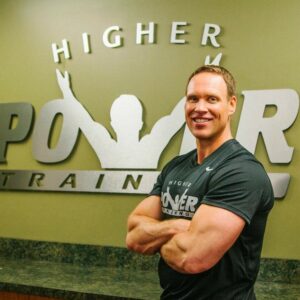Designing group workouts in a facility that caters to personal training, members, and group training takes some careful pre-planning and thought. The program needs to be structured to maximize work time and minimize rest time. This also needs to be done in a way to keep equipment available for members and personal training clients, but yet guarantee the selected exercises are accomplished. Below are steps I have created to “get in, get strong, and get out”.
Step 1: Choose a training phase
At Higher Power Training, we typically use 4 phases:
- Corrective: This phase will have more corrective exercise work to correct muscle imbalances or rehab exercises if an athlete is still recovering from an injury. The reps tend to be higher in this phase.
- Accumulation: This phase is characterized by a higher volume of work. It is similar to hypertrophy training in utilizing 6-12 reps.
- Intensification: This phase is characterized by periods of higher intensity. It is similar to a strength phase in utilizing lower reps, such as 1-5.
- Power: This phase will incorporate “rate of force development” exercises such as: plyometrics, medicine balls, and Olympic lifts and their derivatives. Strength exercises are still utilized in this phase. Reps tend to be similar to the intensification phase, but may be higher for “power endurance”.
Step 2: Choose exercises relative to the training phase and the “athlete’s needs”
Here is an example of properly choosing exercises for a volleyball team over several phases:
- Corrective: In a corrective phase, focus is on preventing jumpers knee with hamstring work and vmo work. Corrective exercises are added to prevent future shoulder injuries by incorporating mid/ low trapezius and rotator cuff work.
- Accumulation: Use this phase to “accumulate volume” and prep the players for the next “intensification cycle”. Volleyball requires strong powerful shoulders and strong quads so start to prep vertical press patterns with high incline presses and squat patterns with various squats.
- Intensification: Add military presses to develop the vertical press pattern. For squat patterns add squats with chains or bands.
- Power phase. Super set high load exercise such as squats with reactive exercises like squats to develop explosiveness.
Step 3: Determine how many multiples of equipment per exercise will be available
This is the limiting factor. If you will be bench pressing, how many stations are available? At Higher Power Training, we have 5 stations that may be used for upper body pressing patterns and 5 stations that can be used for squat patterns. When training groups, we try to keep 2 stations available for our members / personal training clients. This leaves us 3 stations for upper body press patterns and 3 stations for squat patterns. In order to guarantee our stations, we mark off each station (at least 30 minutes ahead of schedule) for an allotted time. This way, members and trainers know they need to be off that equipment at a certain time. This assures proper flow for your group efforts and accommodates your members at the same time.
Step 4: Determine group sizes based on the limiting factor (how many multiples of equipment are available)
At HPT, we find that an A circuit of 3 exercises, a B circuit of 3 exercises, and a C circuit of 2-4 exercises tend to be optimal. Here is how to organize the flow:
- Groups of 3 work best, followed by groups of 4.
- If you have enough equipment available for your number of groups, the flow goes A, B, then C.
- If you have more groups of 3 or 4 than you have multiples of equipment, divide the groups in half. Half of the group will start in the A series and the other half will start in the B series. If you split your group, one group will flow A to B to C and the other group will be B to A to C. It is not advisable to have a group start with C due to the nature of exercises in this grouping.
- If you still don’t have enough equipment or stations available, you can have another group start with a later start time.
At HPT, we like our workouts to be both safe and very productive. Safety comes from proper technique, proper loads, and of course spotting. Productivity comes from organizing the workout in a way that the athletes are not wasting time waiting to do an exercise.
Step 5: Choose your movement buckets
First, we classify exercise in specific “buckets” (or movement patterns). Here are the buckets:
- Lower body Push: squats, lunges, step-ups, etc.
- Lower Body Pull: RDLs, hip hinges, deadlifts, leg curls, etc.
- Upper Body Push: both vertical and horizontal
- Upper Body Pull: both vertical and horizontal
- Core: anti-extension and flexion
- Core: anti-flexion and extension
Based on the previous movement buckets, the following order and “exercise type” works the best:

Step 6: Utilize the right warm-up order and incorporate spotting exercises in A1 and B1
Begin by being sure to place your spotting exercises in A1 and B1. These will tend to be multi-joint movements such as squats, and horizontal presses and some seated incline work. Keeping this in mind here is an example of how 3 athletes per group would properly incorporate warm-ups.
- Athlete 1 performs warm-up set #1 on A1. Athlete 2 is spotting A1. Then, Athlete 3 performs warm-up set #1 on A2
- Athlete 1 moves on to A2 and does warm-up set #1. Then, Athlete 2 performs warm-up set #1 on A1. Athlete 3 is spotting A1.
- Athlete 2 moves on to A2 and does warm-up set #1. Then, Athlete 3 performs warm-up set #1 on A1. Athlete 1 spots A1.
- Repeat exact same protocol for warm-up set #2.
- The same protocol is followed for the B series.
So if you are all about getting in, getting strong, and getting out to improve your weight room management, use these 6 steps!





